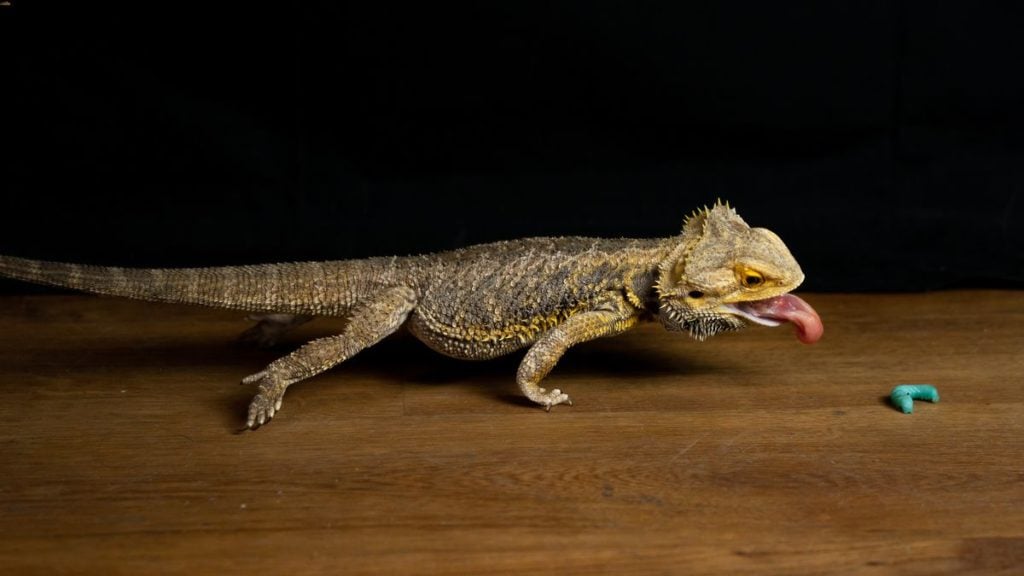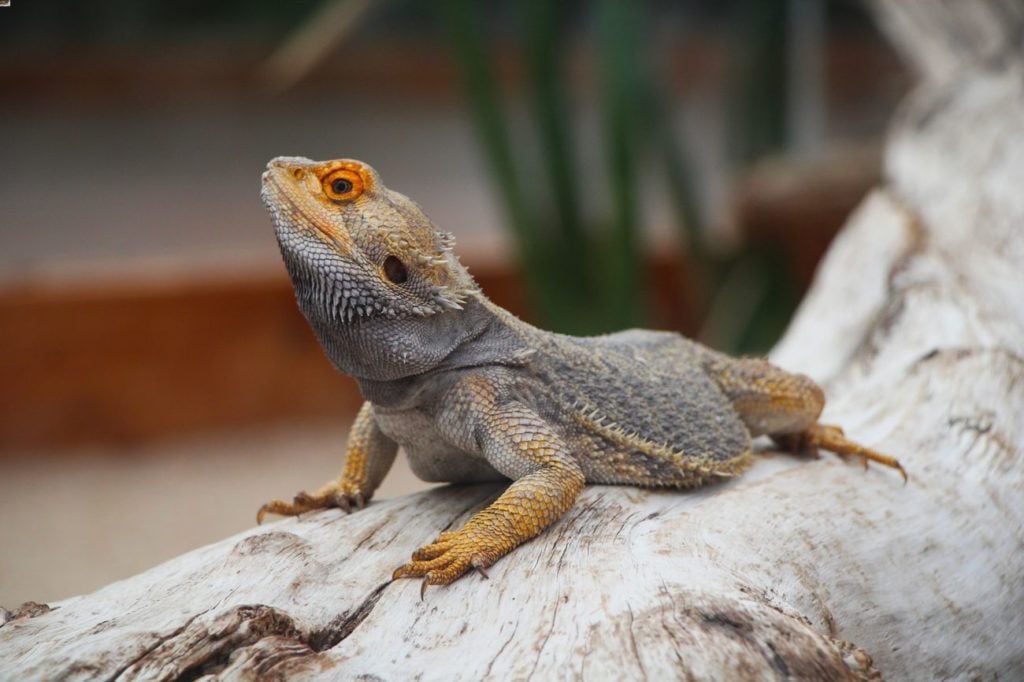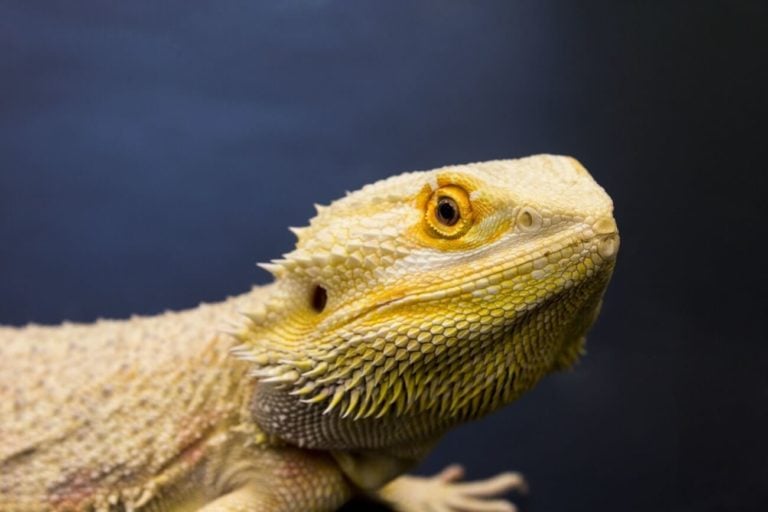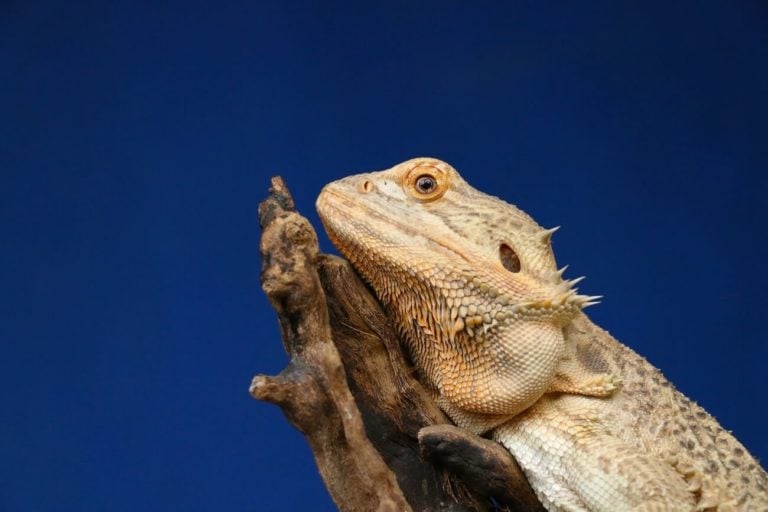For new owners, knowing the average bearded dragon lifespan (and what impacts it) is very important. We believe it’s valuable knowledge that will help you provide better care over time.
This guide will teach you everything you need to know about their life expectancy, and how to maximize it!
Table of Contents
How Long Do Bearded Dragons Live?
The average bearded dragon lifespan is between 8 and 15 years in captivity. This range is dependent on the quality of care they receive, as well as a variety of genetic factors.
Expert Tip: This is yet another reason why it’s so important to purchase your beardie from a reputable seller. They’ll live longer!
Factors That Influence Their Lifespan
How long a bearded dragon lives depends on many factors. These include where they live, how well they are cared for, their diet, gender, genetics, medical care, and environmental factors.
It’s important to remember that there’s never a guarantee when it comes to the lifespan of a bearded dragon (or any pet). You can do everything right and still see your pet fall victim to a bad luck illness.
However, statistically speaking, you can significantly increase the chance of your bearded dragon living for a long time by doing the right things.
1. Diet
A healthy diet will make a big difference on the lifespan of your bearded dragon. Just like people (or any other animal), the quality of what you feed them will help them stay healthy and combat disease.
Bearded dragons are omnivores, meaning they eat both animal-based and plant-based foods. A well-balanced and nutritious diet is important if you want to maximize the life expectancy of your beardie.
What you feed your beardie will depend on their age. Young lizards need a diet that’s high in protein, so they should be fed a diet containing 80% insects and 20% vegetables and greens.

Bearded dragons are considered to have reached maturity by the time they turn 18 months old. As an adult, your beardie is done growing and will need less protein in their diet as a result. Adult lizards should be fed a diet containing 20% insects and 80% vegetables and greens.
Expert Tip: It’s important to adjust their diet over time to suit their age. Owners that don’t will typically see their bearded dragons have a much shorter lifespan.
Beardies like a variety of insects, including but not limited to crickets, dubia roaches, moths, cockroaches, slugs, earthworms, grasshoppers, silkworms, and spiders.
It can be a little more difficult for you to get your beardie to eat their vegetables and greens, but you can give them a variety of these plant-based foods, including broccoli, mustard greens, kale, collard greens, parsley, watercress, parsnips, green beans, cucumbers, mushrooms, asparagus, corn, zucchini, pumpkin, peas, and celery.
Bearded dragons like fruit, but fruit should only comprise 10% of your beardie’s diet, no matter how old they are. You can feed your lizard a variety of fruits, such as grapes, apples, mangoes, peaches, apricots, strawberries, blueberries, tomatoes, grapefruit, pineapple, and watermelon.
In summary, your beardie has a great chance of living for a long time if you provide them with the right dietary ratio and variety!
2. Habitat & Enclosure
Your beardie needs the proper habitat setup to stay healthy. Bearded dragons came from the desserts in Australia. As such, your beardie’s enclosure needs to mimic this environment. The enclosure you provide your lizard needs to have the right lighting, temperature, and humidity level if you want to maximize their lifespan.
The size of your beardie’s enclosure matters. It is recommended to have a 20-gallon tank for baby beardies, a 40-gallon tank for juvenile beardies 10-16 inches long, a 50-75-gallon tank for adult beardies 16-20 inches long, and a 75-125-gallon tank for adult beardies more than 20 inches in length.
The substrate you use for your bearded dragon will also make a difference in their health. You can choose to use particle or non-particle substrate in your lizard’s enclosure. Be careful though: particle substrate produces dust and debris your lizard can ingest, which may lead to impaction. Impaction can cause serious health issues or even death if it is not taken care of. Particle substrate can also get into your beardie’s nose and eyes, leading to infection.

Non-particle substrate is considered safer for bearded dragons. Some common types of non-particle substrate you can use in your beardie’s enclosure include reptile carpet, non-adhesive linoleum, newspaper, and ceramic tile.
You’ll want to provide your lizard with a platform, such as a large rock or a branch. The platform should allow your beardie to be approximately 10 inches beneath their basking light.
You should also put hides in your beardie’s tank. Not only do beardie’s enjoy crawling into them to sleep, hides are essential in aiding them during brumation. Brumation occurs when your lizard goes into a hibernation-like state in the late fall and winter.
Expert Tip: While not essential, a hammock and safe plants in your beardie’s tank will make them happy (which can help them live longer). Bearded dragons love to hang out in hammocks made for them.
Some safe plants you can put into your beardie’s tank include tillandsia ionantha, Turtle Vince, Jade Plant, and Echeveria. Homegrown herbs, such as rosemary, oregano, parsley, and cilantro are also suitable for your beardie’s tank. It’s important to note that herbs do not thrive in high temperatures, so it’s a good idea to swap the herbs out often.
3. Temperature & Humidity Conditions
Your beardie’s enclosure needs to be kept at the right temperature if you want them to enjoy a long lifespan. Your beardie will need both a basking spot and a cooler spot in their tank. Your bearded dragon will require different temperatures depending on their age and what time of day it is.
More specifically, the basking spot should be 100-110 degrees Fahrenheit for babies and 96-100 degrees for juveniles and adults. The cool part of your beardie’s tank should be 80-90 degrees Fahrenheit for babies and 75-80 degrees for juveniles and adults. Your beardie’s tank temperature should be between 70-75 degrees Fahrenheit at night no matter what age they are.
In addition to a basking light, your beardie needs a UVA/UVB light source in their tank. Light is essential for helping your beardie digest their food, and if you do not provide this light source, they will become very ill.
You’ll want to keep your bearded dragon’s enclosure at a humidity level below 40 percent. You can measure the humidity level in your beardie’s tank with a hygrometer. Failing to do this can lead to respiratory infections (which can shorten their lifespan).
4. Sex
On average, male bearded dragons live longer than females. While this isn’t always the case, it’s important to be aware of if lifespan is a major factor.
Here’s why males tend to live longer:
First, male beardies tend to be larger than females. As you’ll learn in the following section, size can have an impact on lifespan.
Breeding is another reason for this difference in life expectancy. When you breed a female bearded dragon, they have to expend a lot of energy. Even after they have produced eggs, the process takes a toll on their body that doesn’t go away.
Expert Tip: This is the case for most animals when it comes to breeding. If you want your female bearded dragon to live as long as possible, don’t use her for breeding!
5. Size
In general, larger bearded dragons have a longer lifespan than smaller ones. Larger lizards seem to be more resilient than those smaller in size (a good example is comparing the lifespan of a bearded dragon to a Rankin’s dragon).
The best way to ensure your bearded dragon grows as large as they can is to provide them with a well-balanced and nutritious diet and ample space. If your beardie’s enclosure is too small, there’s a chance that they will not eat as much in order to avoid outgrowing their space, so be sure to provide your lizard with a tank with enough space for them to grow.
Keeping them cooped up will also make them uncomfortable and lead to consistently higher levels of stress. This can have a negative impact on their life expectancy as well.
6. Genetics
Like any animal, genetics can make a big impact on the lifespan of your bearded dragon. While this sounds like something you can’t control as an owner, there’s actually something you can do!
When you buy a beardie from a responsible breeder or seller, they are more likely to have healthy genes. That’s because the lizards are bred or sourced from breeders that do things the right way. Responsible sellers will also do their best to ensure your beardie is in good health when they sell them to you.
Expert Tip: One of the best ways to make sure that disreputable sellers stop their poor breeding practices is by not purchasing from them in the first place. In the long run, it’s better for the whole bearded dragon community.
7. A History Of Being Used For Breeding
As we mentioned above, female bearded dragons that used for breeding generally don’t live as long as females who haven’t had babies. Reproduction and egg laying take a serious toll on the female’s body.
We’re not saying that you shouldn’t buy a female beardie that has reproduced (we actually encourage it), but you should be aware of the impact this will have on their lifespan. We love
8. Regular Vet Checkups
It is important for all pets, including bearded dragons, to get regular veterinary exams. Though bearded dragons do not need vaccines, you should take your beardie to a reptile veterinarian once a year for a physical examination.
Your vet should also conduct a feces exam annually to check for parasites. This will ensure that your beardie is healthy, and help them live longer.
Expert Tip: This is one of those things that owners can get lazy about at times. Trust us, it makes all the difference and really isn’t that expensive (we cover that in our bearded dragon cost guide).
What Is Their Lifespan In The Wild?
Bearded dragons spend their days in the wild basking in the sun, hunting down insects, and eating plants. It sounds wonderful, doesn’t it?
However, these lizards also spend a lot of time avoiding their natural predators in the wild. A bearded dragon’s natural predators include dingoes, birds or prey, and large goannas (lizards).
A bearded dragon has an average lifespan of five to eight years in the wild. If a beardie lives longer than eight years in the wild, they are considered to be very old and lucky.
How To Determine How Old Your Bearded Dragon Is
If you don’t know how old your bearded dragon is, there are a couple methods you can use to get a general idea of their age.
For younger bearded dragons, measuring their length may give you an approximate age. More specifically, a beardie that is 3-11 inches in length is approximately 0-3 months old, a lizard measuring 9-22 inches is approximately 4-12 months old, and a bearded dragon measuring 12-24 inches is over 12 months old. It is important to remember that a bearded dragon’s length is influenced by many factors, including the lizard’s species, genetics, and habitat.
Another way you can determine your beardie’s approximate age is by sexual maturity. A bearded dragon reaches sexual maturity between 8 and 12 months of age. Once you can determine your beardie’s gender, you can assume that they are between the ages of 8 and 12 months.
Wrapping Up
The lifespan of a bearded dragon is fairly long, and can be influenced by a number of things. This gives you the ability to increase the amount of time you have to spend with your amazing pet!
We hope this guide has given you some useful knowledge that can help you provide your beardie with top-notch care. They deserve it.


